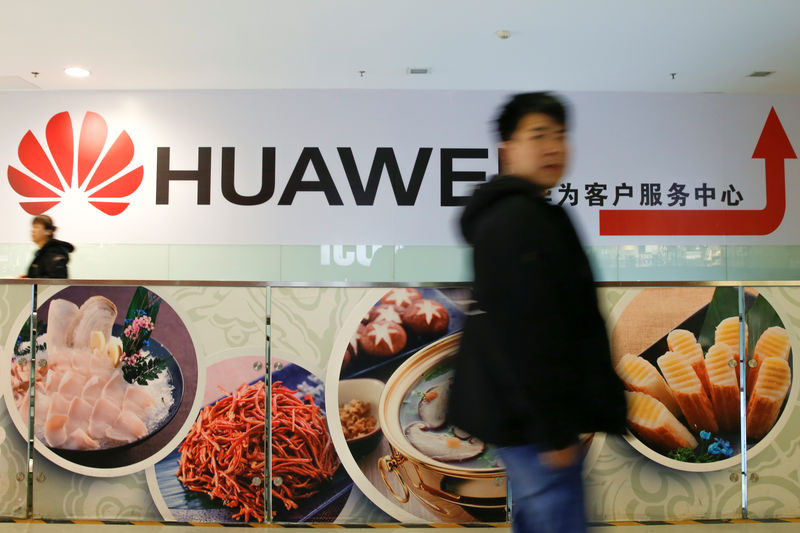Investing
China’s Huawei poised to overcome US ban with return of 5G phones -research firms

© Reuters. A Huawei logo and a 5G sign are pictured at Mobile World Congress (MWC) in Shanghai, China June 28, 2019. REUTERS/Aly Song
2/2
By David Kirton
SHENZHEN, China (Reuters) – China’s Huawei Technologies is plotting a return to the 5G smartphone industry by the end of this year, according to research firms, signalling a comeback after a U.S. ban on equipment sales decimated its consumer electronics business.
Huawei should be able to procure 5G chips domestically using its own advances in semiconductor design tools along with chipmaking from Semiconductor Manufacturing International Co (SMIC), three third-party technology research firms covering China’s smartphone sector told Reuters.
The firms, citing industry sources including Huawei suppliers, spoke on condition of anonymity because of confidentiality agreements with clients.
Huawei declined to comment. SMIC did not respond to a request for comment.
A return to the 5G phone market would mark a victory for the company that for almost three years said it was in “survival” mode. Huawei’s consumer business revenue peaked at 483 billion yuan ($67 billion) in 2020, before plummeting by almost 50% a year later.
The Shenzhen-based tech giant once vied with Apple (NASDAQ:) and Samsung (KS:) to be the world’s biggest handset maker until rounds of U.S. restrictions beginning in 2019 cut its access to chipmaking tools essential for producing its most advanced models.
The U.S. and European governments have labelled Huawei a security risk, a charge the company denies. Since then, Huawei has only sold limited batches of 5G models using stockpiled chips.
Stuck selling last-generation 4G handsets, Huawei fell from most rankings worldwide last year, when sales reached a low point, though it rose to a 10% market share in China in the first quarter, according to consultancy Canalys.
5G FORECASTS
One of the research firms said it expected Huawei to use SMIC’s N+1 manufacturing process, though with a forecast yield rate of usable chips below 50%, 5G shipments would be limited to around 2 million to 4 million units. A second firm estimated shipments could reach 10 million units, without providing further details.
Huawei shipped 240.6 million smartphones worldwide in 2019, its peak year, according to Canalys, before selling its Honor unit that accounted for nearly a fifth of shipments that year.
The state-backed China Securities Journal newspaper this month reported Huawei had raised its 2023 mobile shipment target to 40 million units from 30 million at the start of the year, without referencing a return to 5G phones.
Huawei could produce 5G versions of flagship models like the iPhone rival P60 this year, with new launches likely in early 2024, the three research firms said, adding they were basing such predictions on information they had received via checks with contacts in Huawei’s supply chain and recent company announcements.
However, U.S. restrictions cut Huawei off from Google (NASDAQ:)’s Android operating system and the bundle of developer services upon which most Android apps are based, limiting Huawei handsets’ appeal outside of China.
CHIP DESIGN TOOLS
The research firms noted Huawei in March announced it had made breakthroughs in electronic design automation (EDA) tools for chips produced at and above 14 nanometre (nm) technology.
Chip design companies use EDA software to produce the blueprints for chips before they are mass manufactured at fabs.
The research firms, citing their own industry sources, believe Huawei’s EDA software could be used with SMIC’s N+1 manufacturing process to make chips at the equivalent of 7 nm, the powerful semiconductors typically used in 5G phones.
Washington barred SMIC from obtaining an advanced chipmaking tool called an EUV machine from Dutch firm ASML that is critical in the process of making 7 nm chips.
But some analysts have found signs SMIC has nevertheless managed to produce 7 nm chips by tweaking simpler DUV machines it could still purchase freely from ASML.
The second research firm said it noticed Huawei had asked SMIC to produce chip components below 14 nm this year for 5G products.
The forecast yield rate of less than 50% means that 5G chips are “going to be costly”, said Doug Fuller who researches chips at the Copenhagen Business School.
“I guess if Huawei wants to eat the cost they can do this, but I don’t see such chips as price competitive,” Fuller said.
($1 = 7.2023 renminbi)
Read the full article here

-

 Investing3 days ago
Investing3 days agoThis All-Access Pass to Learning Is Now $20 for Black Friday
-

 Investing6 days ago
Investing6 days agoAre You Missing These Hidden Warning Signs When Hiring?
-

 Passive Income3 days ago
Passive Income3 days agoHow to Create a Routine That Balances Rest and Business Success
-

 Make Money6 days ago
Make Money6 days ago7 Common Things You Should Never Buy New
-

 Side Hustles4 days ago
Side Hustles4 days agoApple Prepares a New AI-Powered Siri to Compete With ChatGPT
-

 Side Hustles5 days ago
Side Hustles5 days agoMIT Gives Free Tuition For Families Earning $200,000 or Less
-

 Passive Income4 days ago
Passive Income4 days agoCustomers Want More Than Just a Product — Here’s How to Keep Up
-

 Investing6 days ago
Investing6 days agoGoogle faces call from DuckDuckGo for new EU probes into tech rule compliance By Reuters


















